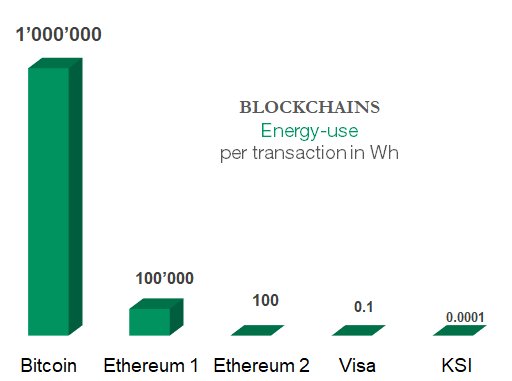Generally speaking, infrastructure and production capacities are the result of several centuries of technological accumulation and modification and have very long life spans. Historically, energy transitions have been slow. It takes decades to change a transmission or electricity network. However, today transition technologies are needed to curtail the impact of climate change, and the time scales for their development and implementation must be drastically compressed.
We take here a quick look at the impact of blockchain on energy consumption and the way forward as it becomes a general-purpose technology deployed for many sectors of the economy.
A comparative electricity consumption of bitcoin
The energy consumption of blockchains has been a heated subject for several years, and particularly nowadays with all eyes on energy costs. A few figures suffice to highlight the key aspects of the debate. Today, Bitcoin alone and its transaction validation process (PoW=Proof-of-Work) consume around 100 to 150 TWh/year of electrical energy. This represents in terms of final electricity around:
- 0,6% of the global electricity consumption (which is in the order of 25,000 TWh/year)
- 6% of the electricity used for digital activity worldwide (including internet)
- 20% of the electricity consumption of the African continent (in the order of 700 TWh/year)
- 80% of the electricity consumption of French households
- 450% of Morocco’s electricity consumption (around 35 TWh/year)
If the power consumption of blockchains is a controversial subject, two other parameters must be considered:
- the energy cost of a transaction (or energy use), and
- the CO2 emissions linked to the nature of the electricity, renewable or not, used by the blockchain’s IT infrastructure (or carbon footprint).
There are different types of blockchains, and their power consumption depends on the mathematical and cryptographic methods used to ensure secure and unforgeable transactions.
Here are some orders of magnitude of the amount of electrical energy needed to make a digital currency transaction depending on the blockchain used:
- 1 MWh for Bitcoin using PoW
- 100 Wh for the new Ethereum which uses another mathematical protocol that is less computationally intensive — the Proof of Stake = PoS
- 10 mWh for Algorand
- 100 µWh for KSI Cash, which uses the KSI blockchain that was operational long before Bitcoin and has been securing the entire administration (health, identity, etc.) of Estonian citizens for over 10 years
- 0,1 Wh for Visa which is not based on a blockchain

In short this means that a KSI Cash transaction uses a billion less energy than a Bitcoin transaction.
Such huge differences open the door to careful consideration when choosing a blockchain, especially for countries with low green electricity production.
Using less electricity for blockchains is urgent, but in addition, electricity sources must not be polluting. The ecological footprint of a blockchain is more subtle to measure. A good proxy is CO2 emissions. What is the situation today?
Progress is going fast, but it is estimated that about 50% of the electricity used is based on an energy mix, and only a few percent of that is attributable to electricity generated by renewable energy.
A Bitcoin transaction made with non-renewable electricity represents a few tens of kg of CO2 emissions, close to that of a passenger on a one-hour flight, while a transaction with the digital currency technology KSI Cash based on KSI blockchain emits only a few hundred micrograms.
There is still a long way to go for consensus mechanisms not to require so much power as it is determined by the price of the crypto currency. But less energy voracious IT infrastructures and cryptographic algorithms will allow for blockchain to continue being adopted by key activity sectors for self-governed, automated exchanges, looking to keep the impact of CO2 emissions under control.
Some creative “Energy Moore’s law” engineering will also be required in computing for smart networks to be able to combine scalability, speed, security and energy efficiency. In the future, the power of quantum computing across sectors and industries will drastically help reduce carbon emissions. But for now, if the frontiers of relative hardware power have been reached for certain, a call for consumer/corporate awareness and behavior change to the “always-on, always-more” attitude seems also relevant.
Sources:
– Cambridge Bitcoin Electricity Consumption index
– Swiss Federal Office for Energy — Blockchain energy consumption 2021
– Wealth and Finance News — CBDC
– A. Buldas et al., IEEE, 2022
